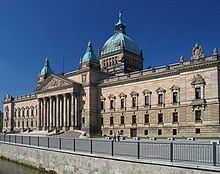Our website is made possible by displaying online advertisements to our visitors.
Please consider supporting us by disabling your ad blocker.
Reichsgericht
| Imperial Court | |
|---|---|
| Reichsgericht | |
 The Reichsgericht building in Leipzig (today the seat of the Federal Administrative Court) | |
 | |
| 51°19′59″N 12°22′11″E / 51.33306°N 12.36972°E | |
| Established | 1 October 1879 |
| Dissolved | 30 October 1945 |
| Jurisdiction | German Empire |
| Location | Leipzig, Saxony, German Empire |
| Coordinates | 51°19′59″N 12°22′11″E / 51.33306°N 12.36972°E |
| Language | German |
| Type of tribunal | Supreme court |
The Reichsgericht (German: [ˈʁaɪçs.ɡəˌʁɪçt], transl. Reich Court or National Court) was the supreme criminal and civil court of Germany from 1879 to 1945, encompassing the periods of the German Empire, the Weimar Republic and Nazi Germany. It was based in Leipzig.
The Reichsgericht began its work on 1 October 1879, the date on which the Reichsjustizgesetze (Imperial Judiciary Acts) came into effect. The acts standardised court types and procedural rules across the newly formed German Empire and established judicial independence and unrestricted access to the courts.[1]
The court's jurisdiction included both criminal and civil cases. It handled appeals, charges of treason and, after 1920, the compatibility of state and national laws. Throughout its life, its major rulings tended to be conservative. They included the conviction of Karl Liebknecht for high treason in 1907, the lenient treatment of the men charged in the 1920 Kapp Putsch and support of the Nazi's antisemitic racial laws.
The Reichsgericht was abolished following Germany's defeat in World War II.
- ^ Rüdorff, H. (1892). Stenglein, M. (ed.). Strafgesetzbuch für das deutsche Reich. Mit Kommentar [Penal Code for the German Empire. With Commentary] (in German). Berlin: De Gruyter. pp. 26–28. doi:10.1515/9783112428047. ISBN 978-3-11-242804-7.
Previous Page Next Page


